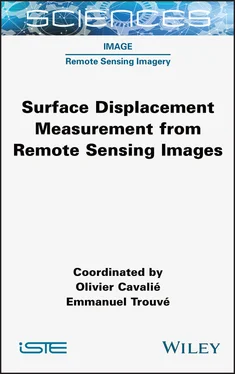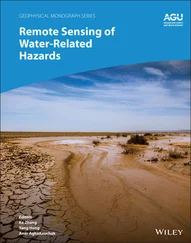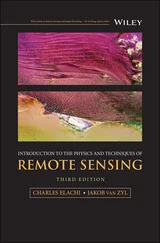Choice of the spectral bands: The choice of spectral bands combined with the spatial resolution directly drive the applications of a satellite. Many satellite systems exist with many different configurations (PAN+XS configuration, only PAN configuration, only XS configuration, etc.). A significant number of UHR and VHR satellites have four bands (blue, green, red and near-infrared) associated with a panchromatic band. The panchromatic band (P or PAN) usually has a spatial resolution four times higher than the multispectral ones (XS). Pan-sharpening techniques are employed in order to build panchromatic plus multispectral (P+XS) products, which means fused multispectral products at a panchromatic spatial resolution.
Table 1.5. Description of spectral bands
| Band name |
Spectral interval |
| UV band |
300–400 nm |
| Visible bands (VIS) |
400–700 nm |
| Near-infrared (NIR) bands |
700–1,000 nm |
| Short-wavelength infrared (SWIR) |
1,000–2,500 nm |
| Medium-wavelength infrared (MWIR) |
3,000–5,000 nm |
| Thermal infrared (TIR)/long-wavelength (LWIR) |
8,000–15,000 nm |
High-resolution (HR) satellites work with lower resolution but include additive infrared bands useful for land cover, water color or atmospheric analysis. To compute digital elevation models and to measure displacements, the spectral band with the highest spatial resolution and the best SNR is generally chosen. For many satellites, this is usually the panchromatic band. For some HR systems with only XS bands, multispectral bands may be used (e.g. Sentinel-2).
1.2. Past and on-going SAR missions
This section presents spaceborne missions that have been used or are used to compute displacement fields by interferometric processing. Some peculiarities or issues are pointed out to help the reader understand them. This is thus not an exhaustive list of SAR space missions. Note that the Magellan mission began to map Venus in September 1990 with an SAR instrument, but its topography was computed using a radargrammetry technique, combining two images from either the same side or from opposite sides: this is rather far from the topic of this book, and thus this very successful mission will not be further detailed here. We must note that most of these missions were organized and designed before the interferometric technique emerged, around the beginning of the 1990s. Thus, certain constraints, such as orbit housekeeping, yaw steering and burst synchronization for ScanSAR modes, were sometimes not taken into account in the designs of the spacecraft or payload.
After a series of C-band and L-band satellites at medium resolution in the 1990s, a new generation of SAR satellites operating in the X-band arrived in Europe at the national level (Germany, Italy, Spain) from mid-2007 onwards: although targeting different goals, they all had significantly improved resolutions and repeat pass capacities, which gave them serious advantages when focusing on localized areas.
With small satellite missions, such as ICEYE, interferometry is usually possible with a short time period: maintaining a small orbital tube is too expensive for the length of the mission and archives on large scales are out of scope; however, such constellations can gather significant data over cities and PS techniques can be considered. NovaSAR is not addressed here, as it is a single satellite on a short-term mission with limited applications for interferometry. Some Chinese and Indian missions are also not addressed due to the limited availability of the datasets. Finally, a significant improvement in interferometric abilities and coverage arrived with missions such as Sentinel-1 and ALOS-2.
1.2.1. ERS-1, ERS-2 and Envisat
ERS-1 (1991–2000) and ERS-2 (1995–2011), the European remote sensing satellites, began the era of SAR instruments in Europe and demonstrated the first applications in radar interferometry. The five-year overlap provided the opportunity to develop very nice orbital combinations, such as the so-called tandem phase, allowing acquisitions of the same area within just a one-day interval, which was much more favorable than the native 35-day repeat cycle for InSAR on rapidly changing surfaces.
The Environmental Satellite (Envisat) continued the C-band SAR missions for Europe with the ASAR instrument, as well as numerous added payloads, among which were the DORIS instrument for precise orbit determination and the MERIS spectrometer, giving simultaneous information on the composition of the atmosphere and overlapping most of the SAR swath. Envisat was put on the same 35-day orbit as the ERS series from April 2002 until October 2010, when a drifting orbit had to be set due to the lack of propellant until its end in May 2012.
ERS-2 had an overlap in the years 2007–2008 with Envisat, with a 30 min delay between the two satellites, but the central frequency was shifted from 5.3 GHz (ERS) to 5.33 GHz (Envisat) so that cross-intereferometry was restricted to common bandwidth in limited cases.
The geometry of ERS satellites was quite simple with a 23° fixed incidence angle, swath of about 100 km and one single polarization set to VV. The Envisat ASAR instrument was more complex, with modes divided in ScanSAR and its large swath of 405 km (composed of five sub-swaths), as well as seven stripmap modes (IS1 to IS7). A wave mode was operated over the ocean. Customers could order any kind of mode, so the archive was not homogeneous over the Earth and strongly depended on the area considered: it therefore became more difficult to get two images acquired in the same mode, suitable for interferometry. However, for some closely monitored volcanic islands, it was quite interesting to get different passes in the 35-day cycle with different incidence angles.
Note also that ASAR was not full polarimetric, but authorized different kinds of scheme, such as the alternating polarization (AP) mode, which could emit alternatively in H and V polarizations and receive H and V.
Some limitations of the missions with regard to interferometry: As these missions were decided before differential interferometry emerged, some limitations had to be tackled (Solaas and Coulson 1994). For ERS-1/2, orbital housekeeping looseness led to perpendicular baselines B ⊥(see section 4.2.2in Chapter 4) higher than the limit of 1,100 m. A preferred value of 600 m was set for B ⊥(see definition in section 4.2), so that a tool to determine which orbits or track frames were compatible for interferometry had to be developed. In addition, the orbit was not known as precisely as the latest SAR missions: orbital fringes had to be removed before interpretation. PRARE, a dedicated instrument for precise orbit determination, failed after several weeks on ERS-1 but lasted several years on ERS-2 and was able to deliver precise ranging accuracy of less than 7 cm.
In contrast to future missions (e.g. ALOS-2 or Sentinel-1), Envisat ScanSAR bursts were not synchronized on board, meaning the Doppler overlaps had random values from one pass to another and were not always compatible. Some results were however published in ScanSAR mode; for instance, for the 2003 Bam earthquake in Iran.
In late October 2010, Envisat got a new orbit cycle of 30 days in a degraded configuration. At this point, interferometry could only work around latitudes of 38° (north and south). As a result, tracks could not be combined with the previous 35-day orbit cycle. However, along-track interferometry in the new geometry could produce interesting results, for example interferograms for the Sendai (Tohoku) earthquake that occurred on March 11, 2011, which led to the Fukushima disaster.
Читать дальше












